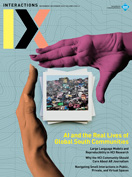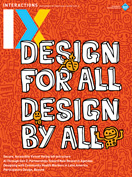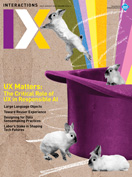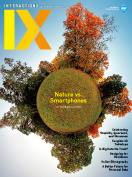Table of Contents
VOLUME XXI.5 September + October 2014
-
Demo Hour
-
Demo hour
Rong-Hao Liang, Liwei Chan, Hung-Yu Tseng, Han-Chih Kuo, Da-Yuan Huang, De-Nian Yang, Bing-Yu Chen, Tobias Grosse-Puppendahl, Sebastian Beck, Daniel Wilbers, Arjan Kuijper, Heejeong Heo, Hyungkun Park, Seungki Kim, Jeeyong Chung, Geehyuk Lee, Woohun Lee, Carl Unander-Scharin, Åsa Unander-Scharin, Kristina Höök, Ludvig Elblaus
1. GaussBricks GaussBricks is a novel building-block system for tangible interaction design that enables real-time constructive tangible interactions on portable displays. The simple mechanical design of the magnetic building blocks facilitates the construction of configurable forms. The forms constructed from the magnetic building blocks, which are connected by magnetic…
-
-
What are you reading?
-
Pernille Bjorn
Pernille Bjørn

Modernity at Large: Cultural Dimensions of Globalization By Arjun Appadurai (1996) The Future as Cultural Fact: Essays on the Global Condition By Arjun Appadurai (2013) Appadurai's work on understanding culture in a global society is a huge inspiration to my work on global software development (NexGSD.org). I am especially…
-
-
How was it made?
-
Vigour
Martijn ten Bhömer, Pauline van Dongen

Describe what you made. Vigour is a rehabilitation tool that enables geriatric patients, physiotherapists, doctors, and family to gain more insight into the exercises and progress of a rehabilitation process. A knitted cardigan with integrated stretch sensors monitors the movements of the upper body to give tailored feedback to…
-
-
Departments
-
Reaching out
Gerrit van der Veer

Each of us knows what HCI means. Most of us have even had some education in this domain, which may have been as little as a chapter in a software engineering course, or as much as a major in interaction design or a Ph.D. supervised by a member of…
-
Community calendar
INTR Staff

September HCI 2014 – 28th British HCI Conference (Southport, UK) Conference Dates: September 9–12, 2014 http://hci2014.bcs.org/ UbiComp 2014 – 2014 ACM International Joint Conference on Pervasive and Ubiquitous Computing (Seattle, USA) Conference Dates: September 13–17, 2014 http://ubicomp.org/ubicomp2014/ ISWC 2014 – 18th International Symposium on Wearable Computers (Seattle, USA) Conference…
-
-
Columns
-
How green building is redesigning the user
Jonathan Bean

The houses at the 2014 Solar Decathlon competition, held this summer in Versailles, France, exhibited a number of recognizable design strategies: adding to the top of existing structures; assembling modular, prefab elements combining kitchens, bathrooms, and heating and cooling systems; wrapping existing buildings with a new, efficient layer. Only…
-
Scrupulous, scrutable, and sumptuous: Personal data futures
Elizabeth Churchill

In creating a multimedia travelogue of my recent trip to Europe, I checked in to the most interesting places I visited using the location-based service Foursquare [1]. Launched in March 2009 and serving more than 50 million users, Foursquare is a social networking site that lets you bookmark (i.e.,…
-
Design fictional interactions
Theresa Tanenbaum

The notion of design fiction is relatively new to the scene of HCI and interaction design research, but increasingly prevalent. First coined by science fiction author and futurist Bruce Sterling in his 2005 book Shaping Things, the term has found adherents within the HCI community, driven in part by…
-
-
Day in the Lab
-
The computer-mediated living group, Microsoft Research Cambridge
How do you describe your lab to visitors? ? The Computer-Mediated Living group (or CML) is one of five main research groups at Microsoft Research in Cambridge, England. The lab itself is the European arm of Microsoft Research, located in the heart of Cambridge in a new building next…
-
-
Forums
-
Next steps for sustainable HCI
M. Silberman, Lisa Nathan, Bran Knowles, Roy Bendor, Adrian Clear, Maria Håkansson, Tawanna Dillahunt, Jennifer Mankoff

We want to change things for real, not just write papers.—E. Eriksson, workshop participant Six years after the workshop on "defining the role of HCI in the challenges of sustainability" [1], that role remains unclear. In 2010, DiSalvo, Sengers, and Brynjarsdóttir identified five distinct genres in sustainable HCI (SHCI).…
-
House memory
Tao Dong, Mark Newman, Mark Ackerman

In the past few years, we have seen a wave of new "smart" consumer products that make everyday places aware of our activities. There are thermostats that adjust temperatures based on occupancy [1], doors that alert us when we forget to close them, and "beacons" that track our indoor…
-
The invisible work of health providers
Yunan Chen, Karen Cheng, Charlotte Tang, Katie Siek, Jakob Bardram

In the era of Health 2.0, we see more novel technologies, such as mobile health applications, wearable self-tracking devices, and new communications media, being designed and developed for health consumers. With these technologies, patients can manage their own health conditions through apps, connect with other patients or health providers…
-
HCI public policy issues in U.S. libraries
Jonathan Lazar, Mega Subramaniam, Paul Jaeger, John Bertot

Cultural institutions such as museums, archives, and libraries often adhere to specific public policy requirements relating to the presentation of digital interfaces and information. With a mission of universal service to their communities, libraries must navigate unique public policy challenges related to interaction design. Meeting this mission can be…
-
Professional UX credentials: Are they worth the paper they’re printed on
Anna Wichansky

The value of credentialing in various occupations is well-known. We would never consider going to a physician who was not licensed. Similarly, we wouldn't want our tax returns filed by an accountant who wasn't certified. In addition, some everyday activities, such as voting, owning a car, or collecting money…
-
-
Features
-
HCI for personal genomics
Orit Shaer, Oded Nov

Recent advances in genetic testing and Internet technologies have led to a dramatic increase in the access non-experts have to their own personal genomic information. As a result, individuals are confronted with an unprecedented amount of sensitive information about themselves, which influences their decisions, emotional state, and well-being [1,2].…
-
In big data we trust?
Juha Lehikoinen, Ville Koistinen

Suppose you need to make a decision about your Web-store entry-page design. The data tells you that the more you leverage search and filtering, the more users will view your products, so you create a design in which users can easily see all of the different ways of looking…
-
Tangible 3D tabletops
Peter Dalsgaard, Kim Halskov

There has recently been a dramatic increase in multitouch tabletop interfaces, but like most physical tabletops, these interfaces are flat and two-dimensional. In our research laboratory, CAVI [1], we have for the past four years examined the potential of extending the tabletop interface into the third dimension [2,3,4]. We…
-
Compassion vs. empathy: Designing for resilience
Dorian Peters, Rafael Calvo

How is it that some people can spend their days making progress on the front lines of sickness or injustice while others can barely handle watching the nightly news? Empathy is critical to our relationships, our societies, and our individual well-being, but it can also hinder these, leading to…
-
Stupidity, ignorance, and nonsense as tools for creative thinking
Dimitris Grammenos

Creative thinking, also referred to as thinking "out of the box," is currently regarded as a key job skill and a core competency able to produce economic value. But as any parent knows, young children do not need to be taught how to think out of the box. They…
-
Online ethnography
Valérie Bauwens, Patrick Genoud

Lessons Learned "I would like us to get closer to our citizens." This claim from the Geneva State Councillor in charge of mobility [1] in 2010 was the inspiration for our "augmented citizenship project" that we lead in the summer of 2013. We made our minister's wish come true…
-
-
Visual thinking gallery
-
Hired
Cassiopeia Winslow-Edmonson

Genre: Conceptual blending There is still a ways to go in achieving gender equality. ©2014 ACM1072-5220/14/09$15.00 Permission to make digital or hard copies of all or part of this work for personal or classroom use is granted without fee provided that copies are not made or distributed for…
-



